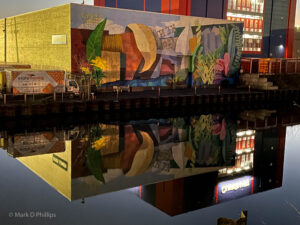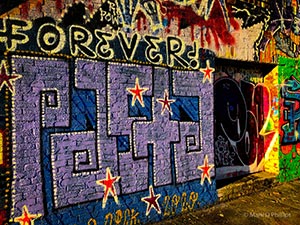Covid-19 unleashed a dystopian opportunity for developers to change the landscape in the Gowanus neighborhood at a frightening pace. Many unique buildings and urban artscapes vanished in the silence of the pandemic.
I gained a fascination with this putrid, stinking body of water that cuts through my neighborhood in Brooklyn. Sort of hidden from the beauty of Brownstone Brooklyn, the canal was surrounded by industrial buildings nestled in the lowlands between the gentrified neighborhoods of Boerum Hill, Cobble Hill, Carroll Gardens and Park Slope. It was a nowhere land with a toxic history. Today, it is a Superfund site. Every time I visited the canal during the pandemic, another building was gone. One of my favorite businesses, Lavendar Lake, a restaurant with the Canal’s former moniker, closed just recently as the pandemic finally waned.

We are hoping for a Brooklyn Utopia along the Gowanus Canal but the current plans put forth in the time of Zoom meetings seem to lack any forethought of using the waterway as a waterway. The water will be cut off from the public by monstrous residential units with no water access.
The Gowanus Canal Conservancy seeks to ensure the community has a key role in shaping a watershed that is accessible, active, and clean for all. In one vision of the future, through their Gowanus Lowlands Master Plan, the GCC presents a community-based vision for a restored public realm and open space network centered around the Gowanus Canal and its watershed. Check out GCC’s Hall of Gowanus digital StoryMap which lets you explore historic and contemporary maps, photographs, timelines, and tools for a unique online visit to the Gowanus neighborhood.
The Gowanus Dredgers Canoe Club is a volunteer organization dedicated to providing waterfront access and education to the public. Their headquarters is located on the Gowanus Canal in the 365 Bond building, which has become a gathering point for events on the canal. This past Wednesday, I stumbled into the Boathouse Jam, a weekly gathering of anyone with an acoustic instrument and a propensity for sitting in a circle while playing. Friday’s have become a staple of comedy on the canal, and on Earth Day, April 23rd, you can help clean the shoreline to celebrate the rebirth of the waterway. If weather cooperates and the EPA suspends boating restrictions for one day, the Dredgers may offer 15-30 min canoe voyages on the canal.

The reflection of the flowering mural inspired by Mexico City’s floating gardens belies the Superfund status of the Gowanus Canal. As the canal goes from industrial based to gentrified, one of the last remaining businesses, Dykes Lumber, has been a fixture on the Gowanus Canal in Brooklyn, NY, since 1986. As awareness rises about the state of the canal, the company allowed the “Gowanus: Industry & Ecology,” mural, by artists Julia Whitney Barnes and Ruth Hofheimer, to be painted on the side of the building at Sixth Street and the Fourth Street basin.
There are very few times where the water is calm enough and the light hits just right to create a frenzy of color on the surface of the Gowanus Canal, reminiscent of the earlier oil slicks of color. Just as beautiful.












